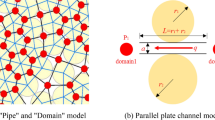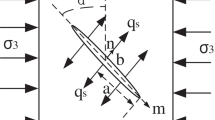Abstract
The rational choice of perforation arrangement and injection angle is of great significance to improve the efficiency of synchronous fracturing and to achieve the stimulation of the shale reservoir. In this paper, the influence of perforation angle and perforation arrangement on the crack propagation mechanism and rock failure mode of synchronous fracturing is studied based on the particle discrete element software PFC. Results show that due to the influence of the stress shadow effect, elliptical cutting cracks are produced between perforations during the synchronous fracturing. When the perforations are arranged in alignment, the fracture mode of rock mass between the perforations is single crack cutting failure under low injection angle, and double-crack cutting failure under high injection angle. Meanwhile, when the injection angle tends to the direction of maximum principal stress (\(\uptheta\) ≥ 60°), the fracturing effect can be greatly improved. In addition, the small perforation spacing under the high principal stress difference is more conducive to the fracturing of the central rock mass. When the perforation is staggered arrangement and the horizontal distance between the perforation centers is the perforation length, it is easy to form the intersection phenomenon of wing cracks under the high principal stress difference, which is more conducive to the realization of fracturing in the central rock mass. In addition, high injection angle is more conducive to the formation of penetrating cracks, but not easy to achieve the central rock mass fracturing. The findings of this study can help for a better understanding of crack propagation law and rock failure mode under different perforation arrangements, which can provide some theoretical guidance for the field synchronous fracturing construction.






















Similar content being viewed by others
Explore related subjects
Discover the latest articles, news and stories from top researchers in related subjects.References
Barati R, Liang Jennmilai (2014) A review of fracturing fluid systems used for hydraulic fracturing of oil and gas wells. J Appl Polym Sci. https://doi.org/10.1002/app.40735
Bu L, Li SC, Shi SS et al (2018) Numerical investigation to influence of perforation angle on hydraulic fracturing process. Geotech Geol Eng. https://doi.org/10.1007/s10706-018-0672-y
Chen H, Hu Y, Kang Y et al (2019) Fracture initiation and propagation under different perforation orientation angles in supercritical CO2 fracturing. J Petrol Sci Eng 183:106403
Cheng W, Gao H, Jin Y et al (2017a) A study to assess the stress interaction of propped hydraulic fracture on the geometry of sequential fractures in a horizontal well. J Nat Gas Sci Eng 37:69–84
Cheng W, Jiang GS, Tian H, Zhu Q (2017b) Numerical investigations of the fracture geometry and fluid distribution of multistage consecutive and alternative fracturing in a horizontal well. Comput Geotech 92:41–56
Cheng W, Jiang GS, Jin Y (2017c) Numerical simulation of fracture path and nonlinear closure for simultaneous and sequential fracturing in a horizontal well. Comput Geotech 88:242–255
Cundall PA (1971) A computer model for simulating progressive, large scale movement in blocky rock systems. Symp ISRM Nancy France Proc 2:129–136
Dong Z, Tang S, Gamage Ranjith P et al (2018) A theoretical model for hydraulic fracturing through a single radial perforation emanating from a borehole. Eng Fract Mech 196:28–42
Fallahzadeh SH, Rasouli V, Sarmadivaleh M (2015) An investigation of hydraulic fracturing initiation and near-wellbore propagation from perforated boreholes in tight formations. Rock Mech Rock Eng 48(2):573–584
Fan Y, Zhu ZM, Zhao YL, Zhou CL et al (2019) The effects of some parameters on perforation tip initiation pressures in hydraulic fracturing. J Petrol Sci Eng 176:1053–1060
Gao CL, Zhou ZQ, Li ZH et al (2020) Peridynamics simulation of surrounding rock damage characteristics during tunnel excavation. Tunn Undergr Space Technol. https://doi.org/10.1016/j.tust.2020.103289
Hossain MM, Rahman MK, Rahman SS (2000) Hydraulic fracture initiation and propagation: roles of wellbore trajectory, perforation and stress regimes. J Petrol Sci Eng 27(3):129–149
Itasca (2005) Consulting Group. Verification problems and example applications. USA: Minneapolis
Ito T, Evans K, Kawai K et al (1999) Hydraulic fracture reopening pressure and the estimation of maximum horizontal stress. Int J Rock Mech Min Sci 36(6):811–826
Li ZC, Li LC, Tang CA (2015) Numerical analysis on hydraulic fracture initiation and penetration characteristics in directionally perforated horizontal wells. Oil Gas Geol (Chinese) 36(03):504–509
Liu C, Wang XL, Deng DW et al (2016) Optimal spacing of sequential and simultaneous fracturing in horizontal well. J Nat Gas Sci Eng 29:329–336
Ren L, Su Y, Zhan S et al (2018) Fully coupled fluid-solid numerical simulation of stimulated reservoir volume (SRV)-fractured horizontal well with multi-porosity media in tight oil reservoirs. J Petrol Sci Eng. https://doi.org/10.1016/j.petrol.2018.11.080
Rongved M, Holt RM, Larsen I (2019) The effect of heterogeneity on multiple fracture interaction and on the effect of a non-uniform perforation cluster distribution. Geomech Geophys Geo-Energy Geo-Resour 5:315–332
Sobhaniaragh B, Mansur WJ, Peters FC (2018) The role of stress interference in hydraulic fracturing of horizontal wells. Int J Rock Mech Min Sci 106:153–164
Tang SB, Liu XJ, Luo J et al (2017) Theoretical model for tensile and shear crack initiation at the crack tip in rock subjected to hydraulic pressure. J Rock Mech Eng (Chinese) 36(09):2124–2135
Tang HY, Wang SH, Zhang RH, Li SB et al (2019) Analysis of stress interference among multiple hydraulic fractures using a fully three-dimensional displacement discontinuity method. J Petrol Sci Eng 179:378–393
Vandenhoek PJ, Vandenberg J, Shlyapobersky J (1993) Theoretical and experimental investigation of rock dilatancy near the tip of a propagating hydraulic fracture. Int J Rock Mech Min Sci Geomech Abstr 30(7):1261–1264
Wang ZS (2019) Study on mechanism and discontinuous deformation analysis of hydraulic fracturing of rock. Shandong University
Wang Y, Li X, Li SD et al (2015) Influence of reservoir heterogeneity on hydrofracture. J Eng Geol (China) 23(03):511–520
Wanniarachchi WAM, Ranjith PG, Li JC, Perera MSA (2019) Numerical simulation of foam-based hydraulic fracturing to optimise perforation spacing and to investigate effect of dip angle on hydraulic fracturing. J Petrol Sci Eng 172:83–96
Warpinski NR (1989) Altered-stress fracturing. J Petrol Technol 41(9):990–997
Wu K, Olson JE (2015) Simultaneous multifracture treatments: fully coupled fluid flow and fracture mechanics for horizontal wells. SPE J 20(02):337–346
Wu K, Olson JE, Balhoff MT, Yu W (2017) Numerical analysis for promoting uniform development of simultaneous multiple-fracture propagation in horizontal wells. SPE Prod Oper 32:41–50
Xie J, Cheng W, Wang R et al (2018) Experiments and analysis on the influence of perforation mode on hydraulic fracture geometry in shale formation. J Petrol Sci Eng 168:133–147
Yi J, Guo JC, Zeng FH (2012) Perforation Spacing Optimization for Staged Fracturing of Horizontal Well. Petrol Drill Tech (Chinese) 40(05):67–71
Yoon JS, Zang A, Stephansson O et al (2017) Discrete element modelling of hydraulic fracture propagation and dynamic interaction with natural fractures in hard rock. Proc Eng 191:1023–1031
Zhang DC, Ranjith PG, Perera MSA (2016) The brittleness indices used in rock mechanics and their application in shale hydraulic fracturing: a review. J Petrol Sci Eng 143:158–170
Zhang BH, Ji BX, Liu WF et al (2017) The study on mechanics of hydraulic fracture propagation direction in shale and numerical simulation. Geomech Geophys Geo-Energy Geo-Resour. https://doi.org/10.1007/s40948-017-0077-z
Zhao JZ, Wang S, Li YM (2012) Difficulties and key techniques in the fracturing treatment of shale gas reservoirs. Nat Gas Ind (Chinese) 32(4):46–49
Zhao JZ, Ren L, Shen C et al (2018) Latest research progresses in network fracturing theories and technologies for shale gas reservoirs. Nat Gas Ind B 5(5):533–546
Zhou D, Zheng P, He P et al (2016) Hydraulic fracture propagation direction during volume fracturing in unconventional reservoirs. J Petrol Sci Eng 141:82–89
Zhou ZQ, Ranjith PG, Yang WM et al (2019) A new set of scaling relationships for DEM-CFD simulations of fluid-solid coupling problems in saturated and cohesiveless granular soils. Comput Part Mech 6(4):657–669
Acknowledgements
Much of the work presented in this paper was supported by the National Natural Science Foundation of China (51879148, 51709159, 51911530214), Shandong Provincial Key R&D Program of China (2019GSF111030), the State Key Laboratory of Mining Disaster Prevention and Control Co-founded by Shandong Province and the Ministry of Science and Technology (MDPC201802), the CRSRI Open Research Program (Program SN: CKWV2018468/KY).
Data Availability
On behalf of all authors, the corresponding author states that there is no conflict of interest.
Author information
Authors and Affiliations
Corresponding author
Additional information
Publisher's Note
Springer Nature remains neutral with regard to jurisdictional claims in published maps and institutional affiliations.
Rights and permissions
About this article
Cite this article
Yang, Wm., Geng, Y., Zhou, Zq. et al. DEM numerical simulation study on fracture propagation of synchronous fracturing in a double fracture rock mass. Geomech. Geophys. Geo-energ. Geo-resour. 6, 39 (2020). https://doi.org/10.1007/s40948-020-00162-0
Received:
Accepted:
Published:
DOI: https://doi.org/10.1007/s40948-020-00162-0




